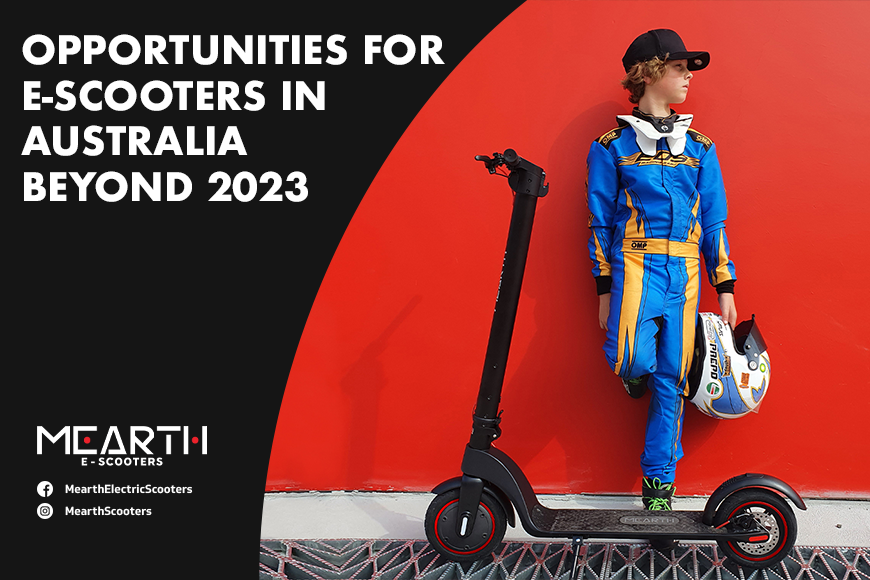
Although this is not breaking news anymore, the global electric scooter market size which was valued at USD 18.6 billion in 2019 is expected to grow at a compound annual growth rate (CAGR) of 7.7% from 2020 to 2027, according to a report by the Grand View Research.
In Australia alone, the demand for electric scooters has increased during the pandemic lockdown. And up to now, it is still increasing, as more people looking for alternative modes of transport that are fun, fast, affordable, and eco-friendly have come to appreciate its manifold benefits.
Thus, the future of the electric scooter market in Australia remains promising -- with opportunities in the retro, standing, and folding scooter markets. The major drivers for this market are increasing consumer awareness regarding eco-friendly transportation, stringent environmental regulations that relate to sustainability, incentives by the government and subsidies programs, and the growing adoption of e-scooter sharing service schemes.
These emerging trends have a direct impact on the dynamics of the transport industry, what with the rising concept of shared e-scooters (rental) and the further improvement of lightweight lithium batteries for e-scooters.
Several trends, opportunities, and forecast in Electric Scooter Market in Australia up to 2028 has been made too, according to product type (retro electric scooter, standing electric scooter, and folding electric scooter); battery type (Sealed Lead Acid Battery, Lithium Ion battery, Others); voltage type (24V, 36V, 48V and >48V), and also technological enhancements and innovation (plug-in and battery).
This is despite the legal status of electric scooters in Australia which is still unclear and varies by state and territory. Currently, only Queensland, the Australian Capital Territory, and the Northern Territory allow electric scooters to be used on public roads and footpaths, with some restrictions on speed, power, and age. In other states and territories, electric scooters are either banned or only permitted on private property.
Amid the challenge that delimits electric scooter enthusiasts and businesses who want to enjoy and promote this emerging form of mobility, it has also created an opportunity for advocacy and innovation, where more people are becoming aware of the benefits of electric scooters and the need for better regulation and infrastructure.
Presented here are opportunities for electric scooters in Australia in 2023 - 2024:
1. Increase consumer awareness and demand. As more people experience electric scooters for themselves or see others using them, they will be more likely to consider buying or renting one for their own use. Electric scooters can offer a convenient and cost-effective way of commuting, especially for short distances or in urban areas. They can also provide a fun and healthy way of recreation and exercise. Moreover, electric scooters can help reduce greenhouse gas emissions and air pollution, as they do not produce any tailpipe emissions and use less energy than cars or motorcycles.
2. Expand product range and quality. There are many electric scooter brands and models available in Australia that cater to different needs and preferences of consumers. Worthy of mention is Mearth, a homegrown, premiere Australian electric scooter brand that is very popular and well-loved. Mearth offers different electric scooter range --from commuter, and long-range, to heavy-duty, on-and-off-road electric scooters, and the recently launched futuristic Mearth Cyber. Each model varies in terms of design, performance, features, price, and warranty. Smart and discerning consumers can choose the best electric scooter, based on their budget, lifestyle, and personal taste.
3. Improve the legal framework and infrastructure. It was that the lack of clear and consistent regulation and infrastructure for electric scooters in Australia has yielded a major hurdle for electric scooters’ adoption and profitable growth. Notwithstanding the obstruction by the opposition against them, it has presented a valuable opportunity to further improve and change in the near future.
To ensure the e-scooter industry’s growth, here are possible measures that the government, commuters, and stakeholders can jointly take to fast-track their support for electric scooters in Australia:
• Develop national standards and guidelines for electric scooters that are based on evidence and best practices from other countries.
• Allow electric scooters to be used on public roads and footpaths with reasonable speed limits (e.g., 25 km/h) and safety requirements (e.g., helmets, lights, bells).
• Provide dedicated lanes or paths for electric scooters that are separated from cars and pedestrians.
• Install charging stations or lockers for electric scooters at strategic locations (e.g., public transport hubs, shopping centers, workplaces).
• Encourage public transport operators to allow electric scooters on board (e.g., busses, trains, ferries).
• Educate the public about the benefits and responsibilities of using electric scooters.
There is no doubt at all that personal mobility devices have the potential to transform the way people move around in this country.
What these rideables can offer is a convenient, affordable, and eco-friendly alternative to cars or motorcycles. But what’s urgent and needs collaborative action to the challenges posed by legal uncertainty, and the inadequate infrastructure.
By rising to the situation, and addressing those very challenges, the opportunities for a lucrative and thriving future are to be expected ahead, where electric scooters can become more than an alternative mode of transport, but a preferred mainstream mode of transport in Australia beyond 2023.




Leave a comment
This site is protected by hCaptcha and the hCaptcha Privacy Policy and Terms of Service apply.